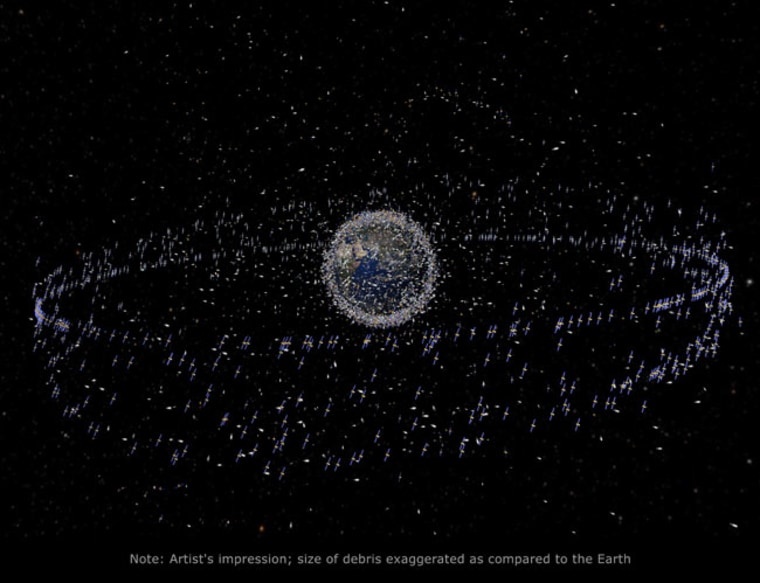What began as a minor trash problem in space has now developed into a full-blown threat. A recent space security report put the problem of debris on equal footing with weapons as a threat to the future use of space.
Hundreds of thousands of pieces of space junk — including broken satellites, discarded rocket stages and lost spacewalker tools — now crowd the corridors of Earth orbit.
These objects could do serious damage to working spacecraft if they were to hit them, and might even pose a risk to people and property on the ground if they fall back to Earth and are large enough to survive re-entering the atmosphere.
The new Space Security 2010 report released by the Space Security Index, an international research consortium, represented space debris as a primary issue. Similar recognition of the orbital trash threat also emerged in the U.S. national space policy unveiled by President Obama in June 2010.
Such growing awareness of the space debris problem builds on stark warnings issued in past years by scientists and military commanders, experts said. It could also pave the way for U.S. agencies and others to better figure out how to clean up Earth orbit.
Consideration of space debris as a major threat may cause the United States to take a more global view on the threat of space weapons, said Brian Weeden, a former U.S. Air Force orbital analyst and now technical adviser for the Secure World Foundation, an organization dedicated to the sustainable use of space.
"This is an important realization, because before that much of the security focus was on threats from hostile actors in space," Weeden explained. "This is the first [national policy] recognition that threats can come from the space environment and nonhostile events."
All those bits of garbage in space could eventually create a floating artificial barrier that endangers spaceflight for any nation, experts said.
The space debris swarm
Even fictional space navigator Han Solo might prefer to risk turbolaser blasts from Imperial starships rather than hazard Earth's growing cloud of space debris, where objects whiz by at up to 4.8 miles per second (7.8 km/s).
The possibility of a damaging collision between spacecraft and orbital junk only continues to grow with more functional and nonfunctional hardware flying above Earth. Both the International Space Station and space shuttle missions have been forced to dodge space debris in the past.
More than 21,000 objects larger than 4 inches (10 centimeters) in diameter are being tracked by the Department of Defense's U.S. Space Surveillance Network. Estimates suggest there are more than 300,000 objects larger than 0.4 inches (1 cm), not including several million smaller pieces.
"The shuttle was more likely to be wiped out by something you didn't see than something you were dodging," said Donald Kessler, a former NASA researcher and now an orbital debris and meteoroid consultant in Asheville, N.C.
But the problem has become much worse since Kessler began studying the issue decades ago with Burton Cour-Palais, a fellow NASA researcher. Their 1978 research described how the debris cloud might continue expanding on its own because of an ever-higher probability of collisions that built upon each past collision.
The Kessler Syndrome
That prediction, known as the Kessler Syndrome, may have already been realized.
China's intentional destruction of an aging weather satellite during a 2007 anti-satellite test created about 2,500 pieces of new debris in Earth orbit.
More recently, a U.S. Iridium communications satellite and a defunct Soviet Cosmos spacecraft were destroyed in an unintended head-on collision in 2009. That incident added more than 1,000 pieces of trackable debris to the mess, adding to the number of possible targets and therefore upping the chances of future collisions.
The overall trackable amount of space debris grew by about 15.6 percent, according to the Space Security 2010 report.
NASA and other U.S. agencies could use national space policy as a chance to aggressively pursue solutions, such as using spacecraft propelled by solar radiation ( solar sails ) or other objects to take down a few select pieces of debris, experts said.
"If we only bring down four objects per year, we can stabilize [the debris field] if we carefully select those most likely to contribute to debris," Kessler told SPACE.com.
Path to cleaner space
The national space policy shift shows that policymakers have finally begun to take action based on the work of Kessler and other researchers, Weeden said.
"This policy basically sets the playing field for what is to come," Weeden said. "It's an enabler, not the actual solution itself."
The United States and other countries could begin discussing voluntary codes of conduct about how to minimize space debris from new missions, as well as how to clean up old space debris.
But legally binding agreements remain politically unlikely, Weeden cautioned. More plausible is an agreement on a strictly volunteer basis that would require spacefaring countries to put peer pressure on one another to comply.
Change of tune
The criticism of past space weapons tests that have created space debris has already changed how countries plan their actions, said Joan Johnson-Freese, a space policy analyst at the Naval War College in Newport, R.I.
"When the United States tested an anti-satellite (ASAT) weapon in 1985 by destroying its Solwind satellite, and China tested its ASAT in 2007, neither broke any 'rules,'" Johnson-Freese said in an e-mail. "But each created a substantial amount of space debris potentially dangerous to other spacecraft."
Both countries have since changed their policies, and said future tests will be characterized as "missile defense," aimed only at destroying targets that won't leave lingering debris, Johnson-Freese pointed out. "In terms of space debris, it is simply not in U.S. interests to pursue paths that encourage actions that result in debris creation."
